Whether you’re a newbie or a seasoned MBA, you’ll FINALLY “get” the big picture
When you can speak the language of Finance, you give yourself an unfair advantage in your career.
It’s an advantage that can lead to confidence, praise, and promotions.
This Online Financial Analysis course by Leila Gharani will equip you with these critical skills – even if you’ve never taken a single finance or accounting class.
Our courses are popular among financial analysts, CFO’s, and business owners


Whether you’re a complete newbie or a seasoned MBA …
When you read financial statements AND provide recommendations, you give yourself an unfair advantage in the workplace.
It’s an advantage that can lead to confidence, praise, and promotions.
It doesn’t matter if you’ve never had formal training and you think you’re unqualified to analyze financial statements.
It doesn’t matter whether you’re working for an employer, run your own business, or you’re an investor.
It doesn’t matter if you’re a CPA or a finance professional who’s been at this for decades.
Upping your game when it comes to analyzing finances is a critical skill. When you not only understand how money is created, how it flows, and how it multiplies, but can also give recommendations… you give yourself one of the most valuable – and lucrative — skills in the world.
Warren Buffett said it best:

Imagine Any Goal You Want To Achieve
For example …
- Getting a job as a financial analyst
- Moving up the corporate ladder
- Deciding on an investment opportunity
- Negotiating a loan
- Finding new opportunities for your clients (and landing betters ones)
- Starting your own business
If you can’t look at a financial statement and immediately get the story it’s trying to tell you, the likelihood you’ll achieve any of these goals is far too low.
Here at XelPlus, we refuse to let any of our students pursue these goals so ill-equipped.
But what if things were different? What if you could read a financial statement with the same ease you read a menu at your local restaurant?
What if you could not only see the numbers, but understand the story they’re trying to tell you?
Do you think your chances of achieve any these goals will improve?
Of course they will.
When you speak the language of finance, doors open.
Here’s the thing:
Anybody can learn to read and analyze financial statements. So then why do so many people struggle in this area?
It’s typically because they’re held back by one of these common myths:
3 Common Myths about Financial Analysis
Myth #1: “I’m Not Qualified”
The nice thing about money is that it doesn’t care about your background. If you hold a paper bill in your hand, it doesn’t care where you were born, where you went to school, or how much training you’ve had.
All that matters is the decision you make about where to spend (or not spend) that dollar.
If you look at your company’s P&L and discover an urgent problem, do you think your boss will care about your college degree?
Do you need a finance degree to warn your friend that their hot new stock tip is a bad idea?
You don’t need to have the right qualifications or a special diploma to make better decisions about money. It’s about understanding and interpreting the numbers.
Myth #2: “I Don’t Work In The Finance Department”
It’s a myth that you must work in finance to study financial analysis.
Here at XelPlus, my online training company, we attract students from all different professions.
Our ranks are full of:
- Engineers
- Lawyers
- Administrators
- Researchers
- Military personnel
- Software developers
- HR professionals
- Management consultants
The list goes on and on.
And yes, we have the “usual suspects” of accountants, controllers, financial analysts, and CFO’s in our student roster, too.
But what does each of these students have in common? For each of them, understanding finances is critical to their career growth.
It’s hard to think of a profession where you wouldn’t benefit from being more financially savvy.
Myth #3: “There’s Nothing New For Me To Learn”
Be careful because this is a dangerous mindset to adopt. Trust me, I’ve been there before.
After achieving my master’s degree in economics, there were times when I got comfortable. There were times when I stopped pushing myself to learn more. When I failed to explore the unknown.
Each time, I was reminded – often harshly – of how much I have yet to learn. Even though I run an Excel-based YouTube channel with over 2 million subscribers, I still push myself to learn more. Learning never ends.
Maybe you’re reading this message as a seasoned financial pro. You’ve put in the years and already understand more about finance than 99% of the population.
I’m not going to pretend every module in our new course will be a revelation to you. Much of it will be old material you grasped long ago.
But no matter our skillset, isn’t it wise to occasionally go back and review its basics? Isn’t it likely there were one or two things you missed?
Plus, the tools are always getting better. I’m willing to bet we’ve found some nifty Excel tricks you haven’t yet discovered.
Remember, there is always more to learn. And you never know what even a single new insight will unlock.

I took over the Controlling Department and as leader for this department I am also more involved in M&A.
After completing the course, I feel a lot more comfortable regarding the explanation of Excel-Formulas and their usage… and also about explaining the financial indicators.
I specifically loved the important ratios to analyze financial statements and the explanations for variance and standard deviation. The course brings Finance to life!
This Online Financial Analysis Course Is Specifically Designed To Help You Analyze Financial Statements Like a Pro
(Even if You’re Not One)
This new (and highly-awaited) course from XelPlus, called Fundamentals of Financial Analysis, will give you the skills needed to reach the next level in your career.
This no-fluff, easy-to-follow online course will help you:
- Develop X-Ray vision into your company’s finances, allowing you to see what’s going on behind the scenes
- Spot oncoming financial emergencies before they happen
- Predict where your company will be months and even years down the road
- Use ratios to quickly gauge the health of your company
- Decide whether to say “yes” or “no” to that new investment opportunity
- Speak with your higher-ups about finances, impressing them with your fluency (they may even begin asking you questions)
- Better manage your household finances, leaving you with more money for savings (and fun vacations)
It doesn’t matter if you’ve never read a book or taken a class on finance.
This new course will make you more fluent and more capable in one of our society’s most important arenas – the area of finance & money.
I can sum up this course in one word: EXCELLENT! I think this course was a great balance of many different aspects of finance. I came into the course thinking it was a focus on accounting, but it covered so many topics.
The course was like taking a mini–Harvard MBA course.
I feel that your teaching method was perfect for me; explain, demonstrate and have me practice. I think I learned more in this course than any other course I have taken. It is hard for me to describe how great this course is.
I think any person in Finance or in any Business position will come away from this course with a tremendous improvement in knowledge and it will improve the value they will bring to their position.
Click the Big Blue Button To Get Started
Whether you’re a newbie or have an MBA in Finance, you’ll FINALLY “get” the big picture.
Five Levels To Understanding Financial Analysis
We put specific attention to the right sequence of topics.
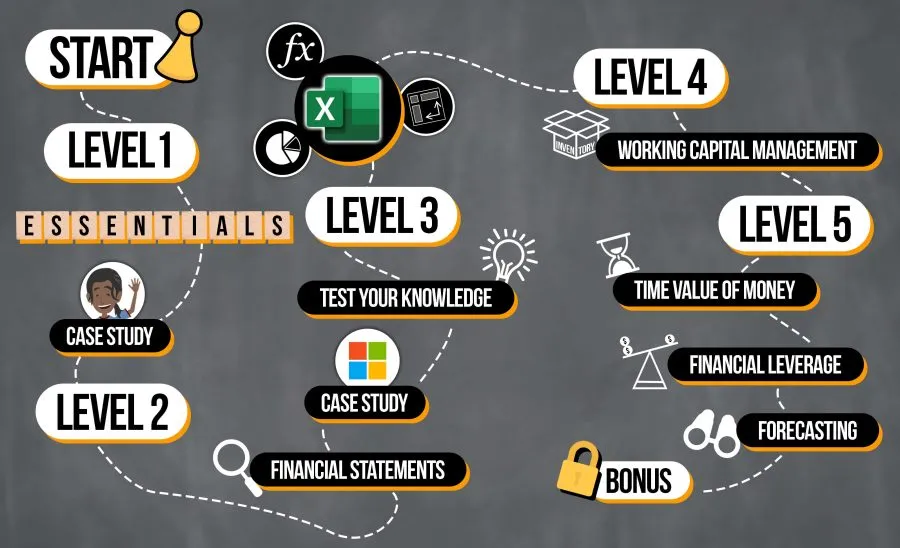

I am a Finance Director with over 20 years of global experience in large multinational companies.
I love the clarity and the sequencing of the subjects! I feel very “refreshed” and confident in terms of the finance basics that have been covered, and am excited to start saving hours of manual work thanks to some of the new Excel techniques that I have learnt.
I’m Leila.
Your Instructor.
Each month, I hop on a special video call with the Microsoft team. This is one of the perks of being a Microsoft MVP. They fill us in on all the latest features coming down the pipeline.
I love these calls and leave them as excited as a kid on their birthday.
But I also ask myself this question: “How are everyday people going to learn this?”
For years, I worked as a project manager at a multinational paper & packaging company. Excel was my #1 tool. Without it, I’d be lost. And let me tell you – I sure worked some magic at that company. Some of the Excel automations I had to create… wow, talk about beasts.
But you know the saying: What doesn’t kill you makes you stronger. And safe to say I can now use Excel with the best of them.

Which Skill Do You Want To Learn Most?
In the list below, you’ll find some of the most useful finance skills.
If these aren’t yet old habit, you’ll be surprised at how quickly you master them when you follow our course’s over-the-shoulder, step-by-step tutorials.
- How to reconcile the flow of financial transactions from journal entries to a trial balance
- How to create and read the main financial statements and how they link
- How to calculate metrics and ratios to judge financial performance
- How to improve cash flow by managing your working capital
- How to prepare Excel so you spend less time doing setup and more time gathering insights
- How to apply theoretical time value of money concepts to real world projects so you make better decisions
- Proven techniques for preparing sound forecasts and budgets
But that’s only a taste of what’s included in this Online Financial Analysis course. You can see the entire curriculum below:
Here’s a Glimpse of Your Learning Path
You can view the detailed curriculum below. Select “See a full outline” to see the list of lectures.
See anything that jumps out? Which lesson do you think you’d begin with?

Fundamentals of Financial Analysis
Whether you’re a newbie or a seasoned MBA, you’ll FINALLY “get” the big picture
When you can speak the language of Finance, you give yourself an unfair advantage in your career.
This course includes:
Over 8 hours of video content spread over 18 modules
Collection of Financial Analysis Cheat Sheets
Downloadable Files to help you work through the problems in the videos
Challenges & Quizzes to test your skills
LIFETIME Access so you never feel rushed
Comment sections to ask questions and get answers from our friendly teaching assistants
CPD Accredited Certificate of Completion
English Closed Captions
Bonus introduction on Power Query to combine and clean data with ease
Section 1: Introduction
Section 2: Financial Analysis Overview
Section 3: Accounting – The Core Principles
Section 4: Accounting Case Study – Accounting for a Beach Business
Section 5: Accounting – Essential Concepts
Section 6: Financial Statements – Income Statement
Section 7: Financial Statements – Balance Sheet
Section 8: Financial Statements – Cash Flow Statement
Section 9: Financial Statement Analysis
Section 10: Time to Test Your Knowledge
Section 11: Necessary Excel Functions for Financial Analysts
Section 12: Important Excel Features for Financial Analysts
Section 13: Master Pivot Tables for Financial Analysis
Section 14: Common Charts & Graphs for Financial Analysis
Section 15: Working Capital Management
Section 16: The Time Value of Money
Section 17: Financial Leverage
Section 18: Financial Forecasting
Next Steps
BONUS: Mini Course – Power Query for Financial Analysts

⏫ Beam Me Up, Scotty!
Jump into the Topic You Need – Fast
As a Star Trek fan, I was always in awe of the transporter technology.
It blew my mind how Captain Kirk could locate a spot on a nearby planet, then instantly transport his team to that exact location.
I want your experience inside this online Financial Analysis course to be just as instantaneous.
Thanks to a new tool we created here in our XelPlus “laboratory,” now, when you want to find a topic, you can do so instantly.
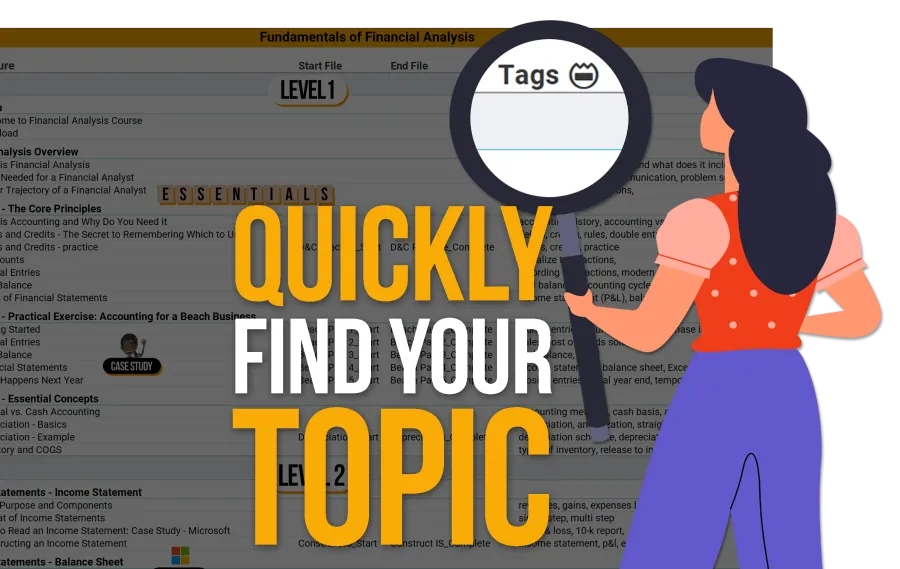
We’ve gone through every second of every lesson and pulled out the key words & topics. Then, we created an interactive agenda which allows you to quickly locate exactly what you’re looking for.
Once you find your topic, it’s simply a matter of saying “Beam me up!” (not actually required). Click the link and you’ll instantly be transported to the correct lesson and timestamp.
No more wasting hours searching. Find what you need, then get back to work.
The course gives the ABCs of financial accounting and financial analysis in the simplest terms, using common understanding. It’s also easy to follow with tailor-made examples.
I took the CORe program from HBS online last year, and I felt that I was losing most of the things I learnt.
This course was exactly what I needed as a refresher, and it’s worth the cost.
My favorite sections are working capital and the whole of Section 5. Understanding how working capital impacts the way we finance our daily operations was eye-opening for me, and I will look at my inventories differently going forward.
Save Time with These Cheat Sheets
Your workday moves fast. Sometimes you don’t even have a minute to spare.
That’s why you’ll love these brand new cheat sheets.
Keep these right beside you at your desk. They may even get more use than your smartphone.
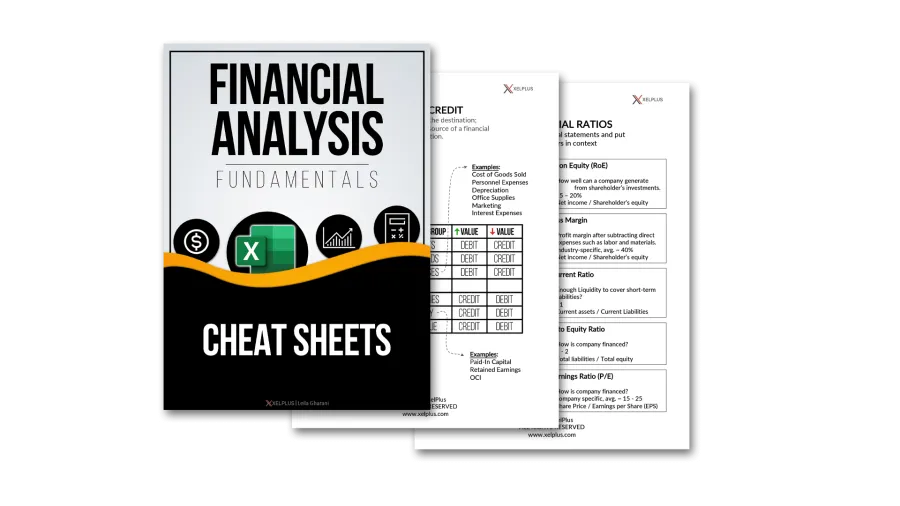
🎁 Bonus: Power Query Introduction-Course
You know the saying: “Garbage in, Garbage out.”
The truth is, you can only be confident in your financial statements if you’re confident in the data you feed into them. And if you’re like many people, you’re working with loads of financial data.
Enter Power Query. This Excel tool is the best way to clean and organize your data. When you get the hang of Power Query, you’ll win back hours of precious time.
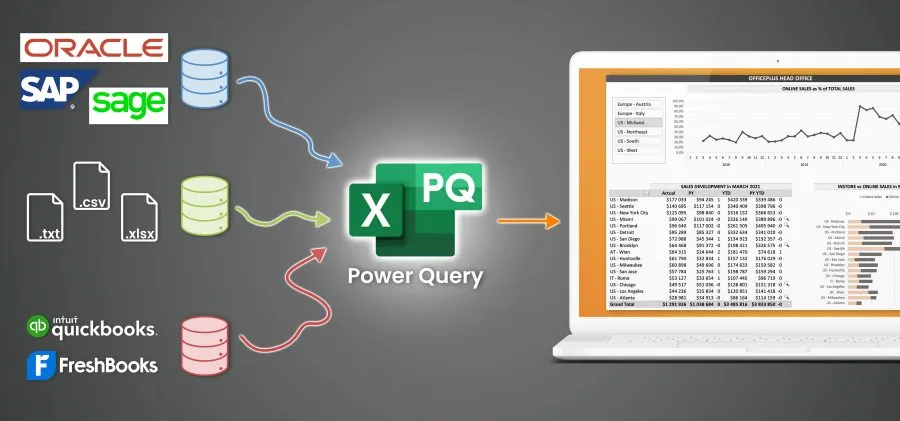
You’ll get our Power Query mini-course as a bonus for enrolling in Fundamentals of Financial Analysis. It will get you started using the tool. You’ll also work with real-world examples of using Power Query to clean accounting and financial data coming from SAP and other common data sources.
(Available 30 days after enrolling)
🆕 Earn CPD Credits
I’m excited to announce this Online Financial Analysis course is now CPD certified. The Continuing Professional Development is a top global accreditation, trusted by companies and industries worldwide.
When you complete this course, you’ll get a special certificate with the official CPD stamp. You will earn 8 CPD hours with the course.
If CPD credits can help in your career, this is not a course to skip.

📃 Get a Certificate of Completion
When you finish the online Financial Analysis course, you’ll get a certificate of completion. You can send it to your boss, upload to LinkedIn, or just add it to your own person library of learning achievements.
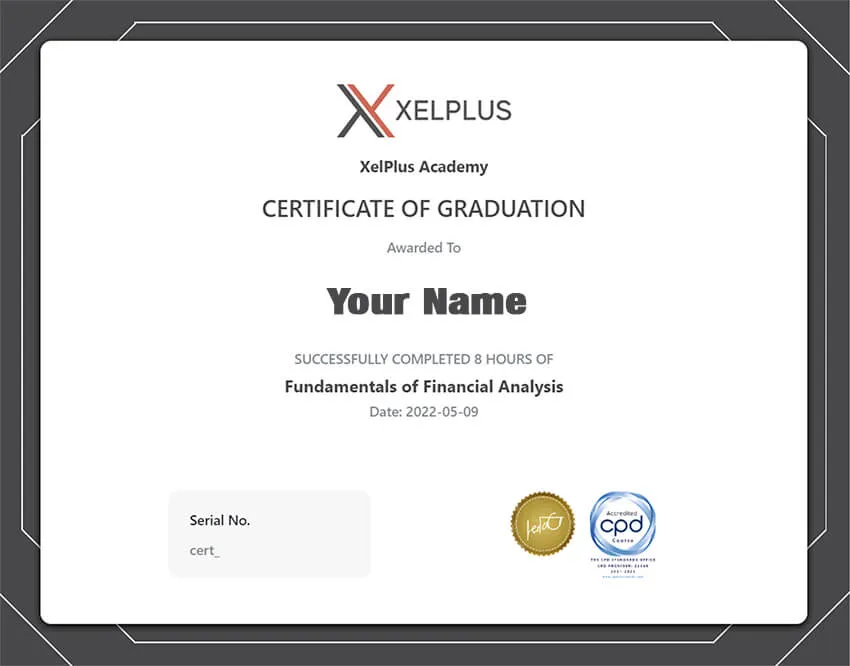
Ask Yourself …
What would even a small improvement in your financial skills be worth over your next five, ten, even twenty years?
How much would having a financial leg up mean for your career?
No, you don’t need to get an MBA and spend $100,000 to learn the most valuable financial analysis skills.
You can learn them from the comfort of your own home. Best of all, you can learn them for a one-time investment of only $179 (excl. taxes).
You’ll get:
- The confidence and rewards that come from being financially savvy
- Access to our entire 18-module course
- Lifetime access, so you’re never in a rush to complete a lesson
- The “Beam Me Up Scotty” topic transporter to quickly find what you need
- Our collection of financial analysis cheat sheets to keep at your desk
- Workbooks to help you work through the problems in the videos
- A comment section to get your questions answered by our staff (how awesome is that?)
- Credits for CPD
- English Captions so you can easily follow along each video
- Quizzes to track how well you understand the concepts
- Challenges to test your financial brain (move over, Lumosity)
- The bonus introduction-course on Power Query to combine and clean data with ease
You have everything in that list for just $179 (excluding taxes). And again, you never lose access. You can see what a great deal this is.
Ready to take advantage? Click the button below and enroll now.
You can be watching the first lesson in less than five minutes.
🤔 Is This Course Right For Me?
Most of our students fall into one of these categories:
Ambitious Beginners
Is your dream to start a career in corporate finance or the financial services industry? Whether you’re a newbie to finance or at the beginning of your career, Fundamentals in Financial Analysis will make sure you get started the right way.
Established Professionals
If you’re ready to deepen your financial knowhow, master new Excel techniques, and advance on the career path, Fundamentals in Financial Analysis will teach you how to fully leverage the language of business.
Can You Afford Not to Have Financial Skills?
Take two people, identical in every way – except one.
They were born in the same place, went to the same school, and even have the same job at the same company.
The difference? One person committed to studying the world finance, while the other constantly put it off. Who do you think will be ahead in their careers ten years down the road?
If you don’t learn financial analysis from me, please, learn these skills somewhere.
But in this message, I think I’ve made a good argument why our online Financial Analysis course is THE best place to get the financial education you need and deserve. Especially given the price and the potential ROI you can achieve.
See you inside the course!
– Leila
Click the Big Blue Button To Get Started
Whether you’re a newbie or have an MBA in Finance, you’ll FINALLY “get” the big picture.
❓Frequently Asked Questions
When does the course start and finish?
You’ll take this online Financial Analysis course in your own time. It is a completely self-paced online course – so you decide when you start and when you finish.
How long do I have access to the course?
How does lifetime access sound? After enrolling, you have unlimited access to this course for as long as you like – across any and all devices you own.
What if I am unhappy with the course?
We would never want you to be unhappy! If you are unsatisfied with your purchase, contact us at info@xelplus.com in the first 14 days and we will give you a full refund.
What if I have questions about the lessons? Can I get those answered?
Yes! Most online courses leave you on your own, but not here at XelPlus.
We have a team of helpful teaching assistants (TA’s) ready to answer your questions about each lesson. Below each lesson, you’ll find a comment section where you can ask a question about the topic. Our TA’s will chime in and do their best to help you.
I’m a beginner. Will this course be too difficult for me?
Not at all! You can start slow, learning the basis, and then step up your knowledge from there.
If you’re a beginner, I recommend you begin with these lessons:
- Accounting Core Principles
- Types of financial statements
- The Beach Business case study (see how these principles work in the real world)
- Cash vs. Accrual accounting
Don’t try to bite off everything at once. Master these fundamentals first, and then you’ll have the skill and confidence to move into the more “ninja” topics.
I’m a seasoned pro and already understand the fundamentals. Will I learn anything new?
Good for you! It’s not easy to make it that far in the world of accounting and finance. You’ve clearly worked long and hard to get to this point.
Yes, this course will still benefit you. For two main reasons…
First, it’s always a good idea to review the fundamentals. Think back to when you were a beginner and everything was new. Was it possible there was something you missed because you were so overwhelmed with the new information?
This is your chance to go back to the basics, now armed with your experienced eye, and see the basics in a new light.
Second, there is plenty of advanced material for you to chew on. Try these on for size…
- Calculating Payback Period
- Compound Annual Growth Rate vs. AAGR
- Mastering Excel’s powerful SUMPRODUCT function
- Regression analysis
How long do I need to devote to this? I’m extremely busy at work.
Ah, I get it. When I was a project manager in the Finance Department at the paper company, I was working 50 hour weeks. I barely had time for family & fun, let alone spending more time at the computer learning.
First, it’s important to look at the big picture. One hour spent learning a faster way to compile data or generate reports can save you dozens or even hundreds of hours over the course of your career.
Don’t look at this course as an extra time burden. Look at it as a way of giving time back to your future self.
If you’re busy right now, block off just 1-2 hours per week. Surely you can find that in your schedule.
Then look at your calendar. If you have a lighter month coming up, make that “learning month.” Block it off now so nothing takes its place. You might even label this block “Invest in my future self.”
During that lighter time, you might devote 5 to 10 hours per week to doing the course & practicing the new techniques.
Again, each hour spent getting better at financial analysis will yield you at least triple that in your future work.
Who can I contact if I have questions not addressed?
You can contact us at info@xelplus.com.


